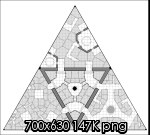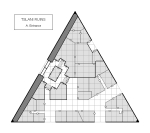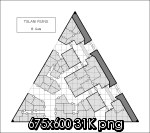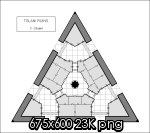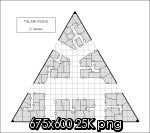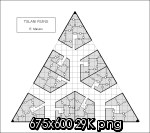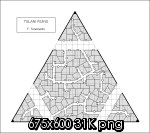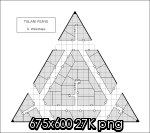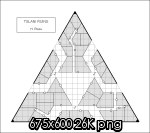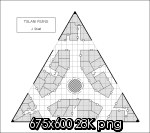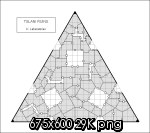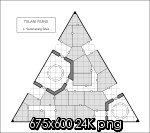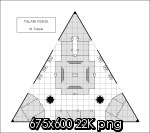
Tslani Ruins, Geomorphs
by Rodger BurnsThese abandoned cities are a common find in the upper reaches of the Alphatian Shadowdeep, and can potentially be found even in other places on Mystara (though they are rare outside Alphatia and Bellisaria). The Tslani were originally a minor culture of mystics, philosophers and conjurers on the Alphatian homeworld; where the Alphatians and Cyprics focused on the heavens, the Tslani were more interested in exploring the depths of the earth. From their own small part of the world-spanning Alphatian empire, the Tslani began delving deeper, building underground citadels and practicing their own esoteric magics.
The Alphatians who fled to Mystara initially thought that the Tslani had all perished with Old Alphatia, collateral damage of the war between the Followers of Air and Followers of Flame. This belief didn't last for long, though - explorers searching beneath the Alphatian continent found enormous caverns, filled with strange fungi, bizarre monstrosities and ghost cities built to the same plan as Tslani fortifications back on Old Alphatia. Somehow, the Tslani had managed to travel to Mystara even before the other Alphatians, and begun building their own civilization there.
Though they've found many ruins beneath Alphatia and neighboring lands, the Alphatians have never managed to find any trace of living Tslani - something that troubles and discourages them. Either the Tslani are in hiding, having delved deeper than the Alphatians are willing to explore and plotting in secret against their surface brethren, or else they somehow managed to destroy themselves in some sort of manner that's left no magical traces of their downfall. Neither possibility is something the rulers of Alphatia want to poke at, and so official policy towards the Tslani ruins is strictly hands-off - to be dealt with by independent adventurers only, so that very little is risked and any accidents can be easily disavowed.
Tslani cities are made out of triangle-shaped city blocks - rotated at 0°, 60°, 120° or 180° to form a larger whole. The typical Tslani city is a multi-layered triangular ziggurat, enclosed on all sides by stone; each level is on average 50' high, with multiple stories of residential buildings and shops inside. Stairs, ladders and levititation magics are used to gain access to upper stories and levels.
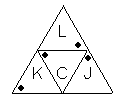
This shows the mapping shorthand for the topmost level of a Tslani ziggurat-city. Each triangle in the map has a letter corresponding to a different city block type (C for Citadel, J for Shaft, K for Laboratory, L for Summoning Site); the dots in the corner show which direction to rotate the topmost corner of the block map. The resulting large-scale map is as follows:
Details on individual city blocks to come shortly.
A. Entrance
This is the typical entrance-gate to most Tslani cities, and showcases their typical defensive philosophy - create a chokepoint in a strong defensive line, ring it with traps and murder holes, and smash enemies as they assault it. While this strategy was ineffective against Alphatian conquest, it was most effective against lesser barbarians and rampaging monsters. Buildings past the citadel walls are storehouses for supplies brought in from outside the city or hostelry quarters for lower-class Tslani visiting from other cities on trade or similar business.
B. Gate
The Tslani were not so foolish as to assume that every enemy would be stopped at the outer entrance to their cities. Gate blocks are used to regulate access to exclusive parts of a city, or sometimes to contain a volatile neighborhood of wizards' laboratories and summoning sites. Neighboring blocks often have an unbroken curtain wall to support the gate block and force travellers through one of the gates. Outside buildings are mainly residential quarters for soldiers' families, taverns and similar entertainment.
C. Citadel
This is a strongpoint within the Tslani city, for use by commanders and quick-reaction forces in case of large-scale riot or invasion. The statue in the center courtyard may be a golem, or focal point of a magical trap.
D. Avenue
This block acts as a nexus for traffic between different parts of the city. Buildings here may be housing for the middle class, upscale shops or guard posts.
E. Manors
Wizard-nobles and the wealthy make their homes in these blocks, along with servants, apprentices and other associates. Exterior walls generally lack windows, even on upper levels; the inhabitants instead use ceiling shafts/skylights, windows onto the central court, and magical means to maintain air circulation and connection to the outside world.
F. Tenements
These cramped blocks are home to most of the lower class of Tslani cities. Most homes and businesses here are only a single room - upper levels are accessed through narrow ladders or steep stepped ramps found outside a building's entrance.
G. Workshops
These are the main industrial sites of the Tslani cities - smithies, weavers, tanners, glassblowers and similar. Raw materials are often acquired through mundane means, but are just as often magically conjured into existence (through Tslani wizards' own spells, or through barter with djinns and efreet). Pure Alphatians back in Old Alphatia apparently considered the Tslani practice of magically creating raw craftgoods to be worked by hand a needless extravagance, compared to simply conjuring up a finished product; the Tslani, in turn, viewed hand-crafting as the only sure way of producing a safe and sturdy end-work.
H. Plaza
This is the main gathering place for workers, shopkeepers and wizard-nobles alike, and the primary access-way to higher levels of a Tslani ziggurat-city. Buildings here are often homes or offices for the prosperous, or barracks and other government offices.
(A note: I. was skipped to avoid any possible confusion with the number 1. This was intentional.)
J. Shaft
Blocks of this type are always found directly above a Plaza block (see H., above). The central shaft is open both to the plaza below and (if other levels exist above) to another Shaft block further up. This shaft is sometimes used by wizards for personal travel, but mostly to levitate up wagonloads of foodstuffs or other supplies to higher levels of the Tslani city; most travellers use the staircases to move between city levels.
K. Laboratories
Blocks of this type are stuffed with buildings used as libraries, classrooms, meditation areas, and other structures important to the wizardly mind. Magic among the Tslani is a fairly competitive endeavour, in its own quiet way - while researchers rarely feud or seek to sabotage each others' efforts, they will try to one-up a rival's accomplishments if possible, and working in seclusion is seen as a sign of lack of confidence...
L. Summoning Sites
Much of the creature comforts of a Tslani city - foodstuffs, cloth and softwoods, inks and dyes, and similar - are acquired not through working the land (for a Tslani city can be miles underground) or trade, but through magical conjuration. Blocks of this type are set up to allow such frequent summoning spells to be practiced in a controlled area, where a mishap or loss of control can be handled with the minimum of fuss. Additional magical research goes on here as well - but it's a reckless mage indeed who leaves the only copy of his work-in-progress where it can be incinerated by a rampaging helion or seized by an angry hydrax.
M. Temple
The existence of these city blocks is a distressing mystery to Alphatian explorers. The Tslani of Old Alphatia had as little in the way of a religious tradition as any culture of their homeworld, preferring instead a triune-elemental philosophy around the mysteries of Air, Fire and Water. (Earth, to the Tslani, was not mysterious; it was omnipresent). Every Tslani city of any size on Mystara, though, has at least one of these temple blocks, dedicated to no power that the Alphatians know of. Explorers are advised to enter these areas only with extreme caution.
